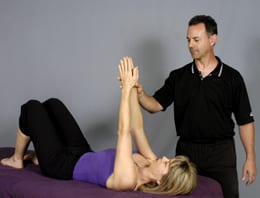by Howard Nemerov
“Jane” reported pain in her left shoulder area. Initial assessment revealed tension along the superior medial border of her left scapula, as well as a zone of spinalis tension along her left lower thoracic spine.
The Nemerov Method explains the “why” that correlates with the “what”. Persistent tension usually is a sign of compensation, where the tight muscles perform extra work for muscles not doing their share of normal work load.
The link between these tight and “weak” muscles is the motor control center, brain functions that learn and remember movement (Brooks: The Neural Basis of Motor Control and others). During an injury event (e.g. trauma, repetitive strain) overloaded muscles “turn off” – similar to what happens when a power surge causes a circuit breaker to turn off, preventing electrical fire – as the motor control center attempts to save muscles, joints and related tissues from further injury.
Yet, the motor control center still must determine how to maintain as much functionality as possible in posture and movement. It achieves this by creating compensation patterns, recruiting other muscles to maintain as much function as possible. Unresolved compensation patterns result in overworked muscles exhibiting persistent tension.
By incorporating the functional principles of motor control theory into manual therapy, you can quickly assess and correct compensation patterns to restore normal muscle function.
In Jane’s case, muscle testing (Kendall, Muscles: Testing and Function) indicated weakness in her left obliques, with compensation provided by the left spinalis thoracis along T8-12. This compensatory relationship only appeared while Jane sat up. This highlights important concepts taught in the Nemerov Method.
In movement, the erector spinae and abdominal muscles are opposites (extension and flexion, respectively). However, in posture, they all provide support by bracing: stabilizing posture in gravity. In this case study, the spinalis and obliques acted as functional synergists, activating concurrently to stabilize the torso and providing a stable foundation for the upper extremity movement.
Movement therapists and trainers call this a kinetic chain: how the movement of one joint (or joints) affects the movement in other joints, in order to create functional movement. In Jane’s case, weakened obliques created instability in the glenohumeral joint during movements involving flexion or horizontal flexion (e.g. anterior deltoid and pectoralis major, respectively.) This in turn expressed as glenohumeral joint pain.
Also while sitting, Jane’s left middle deltoid tested weak, with the left levator scapula compensating. This pattern created two potential symptomatic zones in the shoulder area: the levator scapula and the glenohumeral joint. (To clients, “shoulder” may describe everything from lower cervical erector spinae to muscles operating the glenohumeral joint, and down into the pectoralis minor, levator scapula and rhomboids). To understand how the levator scapula can compensate of the middle deltoid, Tom Myers Anatomy Trains is a great place to start.
The goal of this treatment was to “reprogram” these compensatory patterns so that Jane’s motor center remembered how to move with greater ease following the treatment.
The Nemerov Method training focuses on how to engage the motor control center, while integrating these new protocols with your existing manual therapy. This allows the quick resolution of persistent patterns that express as pain, reduced range of motion, weakness, and tension.
You’ll develop your ability to address unseen causes that create the symptoms you see and feel, and gain a better understanding of functional anatomy, enabling you to create more comprehensive, long-lasting results for your clients.
For further information, or to contact me, visit: http://www.nemerovmethod.abmp.com/ or you can attend the workshop I will be presenting at The Lauterstein-Conway Massage School and Clinic on Jan 30-31,2016. See below for details.
Neuromuscular Therapy: The Nemerov Method
with Howard Nemerov
Sat & Sun, January 30-31, 2016
10am-6pm
$225
14 CE’s


